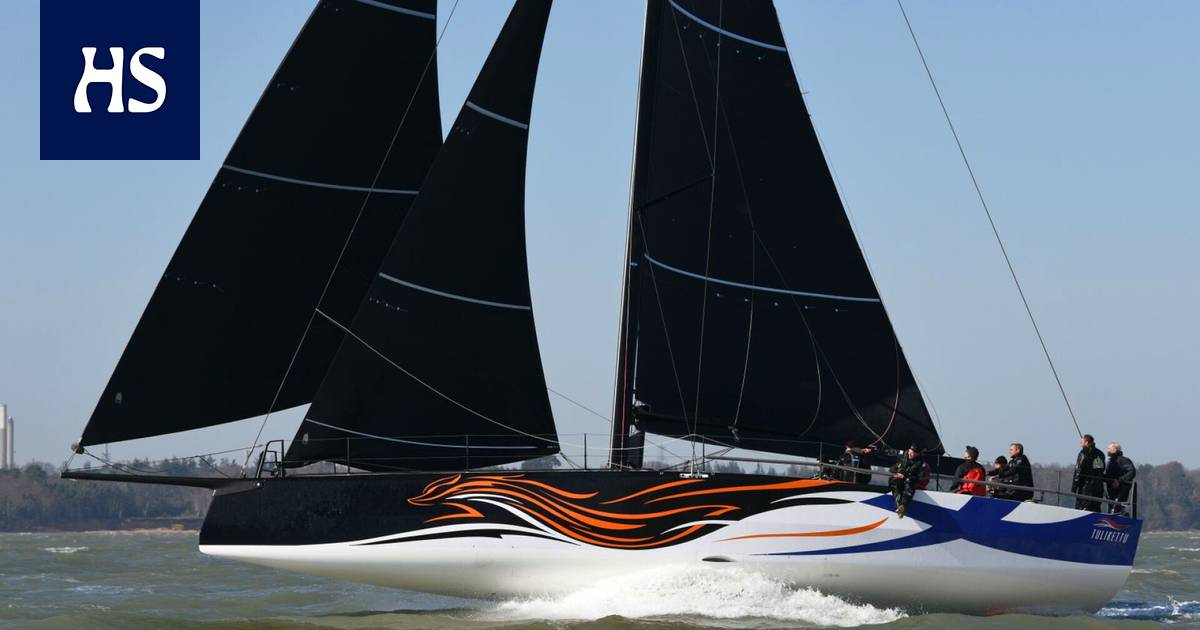Arto Linnervuo, the skipper of the Tulikettu sailboat, now explains why the ship, which cost millions, was left at the mercy of the Atlantic and what happened on a fatal morning.
Finn the ultra-expensive Tulikettu sailing ship had to be abandoned in the North Atlantic off Portugal in April. The boat was to take part in the world’s largest offshore sailing competitions.
The location of the boat remained a mystery after it was abandoned by the transfer crew in an accident.
Now, two and a half weeks after what happened, the owner of the Tulikettu Racing Team sailing stable and the skipper of the boat Arto Linnervuo tells what has survived the accident.
Read more: The most expensive Finnish sailors’ Tulikettu sailing ship collided with a mysterious target in the North Atlantic and disappeared
TuliketUN a four-person transfer crew was sailing from Portugal to England on Monday, April 18th. However, according to Linnervuo, the boat collided with an unidentified object.
The transfer crew made an emergency announcement on the EPIRB emergency transmitter after midnight on Wednesday, April 20th.
Linnervuo himself experienced a nightmare revival on April 18 when an Englishman on the Tulikettu Racing Team Will Jackson called and told about the condition of the boat.
Linnervuo heard that there was an uncontrollable leak in the boat. The situation was serious and constantly getting worse.
The cause or mode of injury was not known and is still unknown.
“
“I was very hopeful that the situation would be taken over.”
The illustration on the left shows Tuliketu’s foil, a kind of wing that allows the ship to reach speeds of up to 30 knots.
According to Linnervuo, Tuliketu’s wing, which attracted a lot of interest, was pulled into the housing inside the hull in the middle of the boat, so it was not in use at the time of the collision. With the help of a foil, the boat travels at speeds of up to 30 knots.
“The winds were against the winds. The speed was the usual rate of creation. ”
According to Linnervuo, the transfer crew included boat builders who had the skills to repair the boat.
“They are very difficult situations at sea when there is a lot of water in the boat and the leak makes all the repairs difficult. I was very hopeful that the situation would be taken over. ”
Arto Linnervuo says that everything is aimed at the team continuing to sail and develop together even after the accident.
Linnervuo says the crew with their recordings were damaged and received footage of what happened. According to Linnervuo, this material cannot be published due to the insurance process.
He says the Portuguese Maritime Rescue Center had directed tankers to the scene of the accident, which had turned towards the location of the boat.
On April 20, the tanker came to the crew evacuated from the boat. The crew of the tanker lifted the Tuliketu transfer crew from the liferaft, which had previously been opened for use at night.
According to Linnervuo, the maritime rescue center that led the rescue operation ordered the crew to take the EPIRB emergency transmitter on board the liferaft, which was also Tuliketu’s operating model.
According to Linnervuo, the purpose of the order was to ensure that the life raft and crew could be found if the evacuation failed. The firecracker had only one boat-specific EPIRB transmitter.
The boat did not have personal PLB transmitters, which, according to Linnervuo, is a mandatory requirement only in Category 0 races, such as the Vendée Globe.
The firewood had MOB-AIS transmitters in the life jackets, which are displayed on the map screens of boats equipped with AIS receivers. According to Linnervuo, these were in use because Tuliketu was to take part in races in which a crew member who got on the water would be rescued by his own or a competing boat.
“
“As soon as the boat had to be abandoned, we contacted the search company.”
Linnervuon According to him, safety equipment and all maritime safety activities are always aimed at saving lives – also in the case of Tuliketu.
“Rescuing the transfer crew was the most important news in a nightmarish situation,” says Linnervuo.
“As soon as the boat had to be abandoned, we contacted the search company. After that, the search boat was set in motion as soon as possible. ”
Getting the reconnaissance boat moving did not go hand in hand. An agreement had to be made with the search patrol, the costs to be paid and the search vessel equipped.
The Fireworks Racing Team knew where the boat had been abandoned and in which direction it would probably drift.
“The search took into account all currents and wind. Sailboat drifting is a little harder to calculate than a motorboat drifting. There is a wider directional wedge at the sailboat, where the boat can drift. ”
Linnervuo says the boat had a transmitting and receiving AIS signal system.
“The problem is that they stop working when the batteries get wet. When the boat was abandoned, all systems and lights were left on, hoping to help them search for as long as possible. ”
Fireworks Racing Team decided to report the accident only after the search was over. After a week, hopes waned. Linnervuo says the insurance company was involved in evaluating the continuation of the search.
“We hope to be covered by insurance.”
The sailing garage is likely to continue its operations on the club’s other boats, at least initially, and to explore the possibility of renting a wing-assisted boat.
The goals of the big competitions still remain.
“I have never seen a single floating container in my life”
About the accident participated in the Vendée Globe sailing around the world after the briefing Ari Huusela said to HSthat there may have been any kind of floating in the ocean, such as refrigerators or sea containers. According to Huusela, the disappearance of a boat in the Atlantic is by no means exceptional.
Another sailor around the world Tapio Lehtinen however, completely disagrees with the risks of offshore sailing with his friend Huusela.
Tapio Lehtinen
Lehtinen does not want to take a stand on the case of Tuliketu. However, he disagrees that colliding with objects like the sea container in the Atlantic would be a high risk.
“I’ve never seen a single floating container in my life.”
According to him, for example, the boats of the Vendée Globe are built in such a way that they have a greater risk of falling apart than other types of boats.
“They’re more likely to break down more easily than any other boat.”
According to Lehtinen, it would be a complete disaster if a boat sank in, for example, the Volvo Ocean Race or the ARC between the Canary Islands and the Caribbean.
“Huusela looks at it from his own perspective when he has sailed in very special races, even though he is an extremely safe sailor.”
Leaflet would like to draw attention to the fact that hydrofoil boats are more likely to collide with ‘unknown objects’ than other boats.
“I think those explanations stink. Whenever these great boats break down, they are said to have collided with something. Those carrier wings are clicking at the pace that you could imagine that a lot of containers would float in the Seas. ”
Although Lehtinen does not want to take a position on Tuliketu’s case, he says that he “completely disagrees with Huusela that such a sinking would be completely normal”.
“I wouldn’t be leaving as a skipper for a 12-person crew to tour the world if it was that kind of gamble.”
#Sailing #Skipper #Arto #Linnervuo #explains #Tulikettu #sailing #boat #cost #millions #abandoned #mercy #Atlantic #happened #fatal #morning









